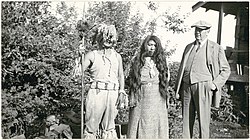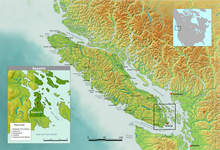Saanich people
This article includes a list of general references, but it lacks sufficient corresponding inline citations. (November 2017) |
 Elsie Copper and her brother, who is wearing traditional Saanich dance regalia. George Gustav Heye, right. 1938 photo, NMAI. | |
| Regions with significant populations | |
|---|---|
| ( | |
| ( | |
| Languages | |
| English, Saanich | |
| Religion | |
| Christianity, Animism | |
| Related ethnic groups | |
| Coast Salish | |
| People | W̱SÁNEĆ |
|---|---|
| Language | SENĆOŦEN |
| Country | ÁLEṈENEȻ (TŦE W̱SÁNEĆ)[1][2][3] |

The Saanich or W̱sáneć (Saanich: W̱SÁNEĆ, [xʷˈsenət͡ʃ], Xwsenəč) are indigenous nations from the north coast of the Gulf and San Juan Islands, southern Vancouver Island and the southern edge of the Lower Mainland in British Columbia.
The W̱SÁNEĆ (weh-saanich) peoples are represented by the Tsartlip (Sart-Lip), Pauquachin (Paw-Qua-Chin), Tsawout (Say-Out), Tseycum (Sigh-Come) and Malahat (Mal-a-hat) Nations.[4] The W̱SÁNEĆ Leadership Council Society consists of three of theses Nations: Tsartlip, Tseycum and Tsawout.[5] These W̱SÁNEĆ First Nations remain on their ancestral lands.
Saanich bands
[edit]- MÁLEXEŁ – Malahat First Nation
- BOḰEĆEN – Pauquachin
- SȾÁ,UTW̱ – Tsawout
- W̱JOȽEȽP – Tsartlip
- W̱SÍḴEM – Tseycum First Nation[6]
Leadership Council
[edit]On May 7, 2018, the W̱SÁNEĆ Leadership Council was created as a representation of the W̱SÁNEĆ First Nations to the Government. The creation of this council not only brought three Indigenous groups together, but it also established a legal governing body. With this council, came many proposals and projects to benefit the W̱SÁNEĆ First Nations.
Includes:[5]
- January 2018, the submission of a proposal for the Government of Canada to make the council a legal governing body (accepted).
- Submission of funding to the federal government's "National Rebuilding" program.
- Negotiations of a government to government project with the Capital Regional District.
Language
[edit]The W̱SÁNEĆ language or Saanich dialect is called SENĆOŦEN.[7] This dialect was revitalized by the late John Elliot, an important member of the W̱SÁNEĆ community and peoples.
ȽÁU,WELṈEW̱ Tribal school
[edit]
Four of the Saanich First Nations, Tsartlip, Pauquachin, Tseycum and Tsawout, created the ȽÁU,WELṈEW̱ Tribal School in 1989. It holds classes from preschool to grade 10, with classes for adults in the adult centre next door to the high school where SENĆOŦEN, the W̱SÁNEĆ language, and W̱SÁNEĆ culture are taught along with the provincial curriculum. The school is also a venue for community events.[8]
See also
[edit]References
[edit]- ^ "Á,LEṈENEȻ ȽTE – Our Homeland". W̱SÁNEĆ Leadership Council. W̱SÁNEĆ Nation. Retrieved 7 November 2023.
- ^ "SENĆOŦEN Survival School". W̱SÁNEĆ School Board. W̱SÁNEĆ Nation. Retrieved 7 November 2023.
- ^ W̱SÁNEĆ School Board; Swallow, Tye (30 November 2018). "Chapter 9 – Learning from the Homeland: An Emerging Process for Indigenizing Education". In Williams, Wanosts'a7 Lorna; Snively, Gloria (eds.). Knowing Home: Braiding Indigenous Science with Western Science, Book 2. ePublishing Services, University of Victoria Libraries.
ÁLEṈENEȻ means "homeland" in the SENĆOŦEN language.
- ^ "Indigenous Relations". Saanich.ca. Retrieved July 22, 2021.
- ^ a b "W̱SÁNEĆ Leadership Council". W̱SÁNEĆ. Retrieved December 10, 2020.
- ^ "Board of Directors". Wsanecschoolboard.ca. Retrieved 12 November 2017.
- ^ SENĆOŦEN
- ^ "ȽÁU,WELṈEW̱ Tribal School". Fpcf.ca. Archived from the original on 2 January 2013. Retrieved 17 April 2012.
Further reading
[edit]- Bill, Adriane; Cayou, Roxanne; & Jim, Jacqueline. (2003). NET'̸'E NEḰA'̸' SḴELÁLṈEW'̲' [One green tree]. Victoria, B.C.: First Peoples' Cultural Foundation & L̵ÁU,WELṈEW̲ Tribal School. ISBN 1-4120-0626-0.
- Mithun, Marianne. (1999). The languages of Native North America. Cambridge: Cambridge University Press. ISBN 0-521-23228-7 (hbk); ISBN 0-521-29875-X.
- Montler, Timothy. (1996). Languages and dialects in Straits Salishan. Proceedings of the International Conference on Salish and Neighboring Languages, 31, 249–256.
- Montler, Timothy. (1999). Language and dialect variation in Straits Salishan. Anthropological linguistics, 41 (4), 462–502.
- YELḰÁTT̵E [Claxton, Earl, Sr.]; & STOLC̸EL̵ [Elliot, John, Sr.]. (1994). Reef Net Technology of the Saltwater People. Brentwood Bay, B.C.: Saanich Indian School Board.
External links
[edit]- An Outline of the Morphology and Phonology of Saanich, North Straits Salish (Timothy Montler's site)
- SENĆOŦEN Classified Word List
- SENĆOŦEN (Saanich, Northern Straits Salish) (Chris Harvey's Native Language, Font & Keyboard)
- Saanich Indian School Board website
- ȽÁU,WELṈEW̱ Tribal School website and photo
